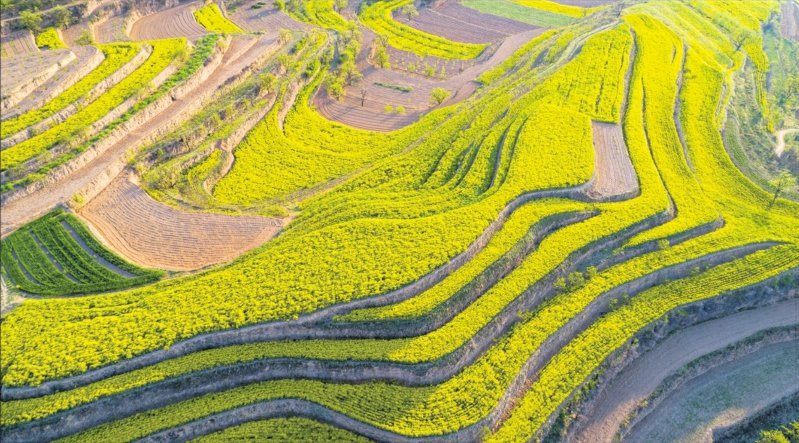
The ancient town of Qikou in Linxian county is one of the most renowned destinations for a tour of the Yellow River. LIU TONG / FOR CHINA DAILY

A medical herbs farm with blooming flowers make the Jiwang Mountain in Jishan county an imposing sight. YANG DEXIN / FOR CHINA DAILY
With the nationwide decline of the novel coronavirus,North China’s Shanxi province has resumed attracting tourists with its beautiful spring sights and ancient cultural assets.
A Libyan student,named Waled,who is studying at the Taiyuan University of Technology,said he plans to visit Datong in northern Shanxi later this month.
“Originally,I planned to visit the city during Spring Festival in late January.However,the trip was delayed because of the COVID19 epidemic,”Waled said.He added that he had been staying in the school for several months.
“I’m bored with this period of time that is mostly spent indoors.I’m longing to go out,even if it is a short trip like the one to Datong,”he said.
He added that the Yungang Grottoes in Datong is what attracted him.“There are a lot of Buddha statues in the city and there are even some relics left by the ancient Arabians,”Waled said.
Even expatriates from Shanxi who live abroad are expecting to go back home,visit their families and friends and take sightseeing tours.
Lisa,a woman originally from Shanxi and who currently lives in Sweden after marrying a local Swede,said she used to go back to Shanxi almost once a year to visit her parents.
“Several days ago,I dined in a Chinese restaurant called Peony in Stockholm.The very name reminded me of my hometown of Taiyuan,where the peony flowers bloom during this period of time.
“My friends in Taiyuan are sharing on WeChat pictures of peonies in Yingze Park and Yongzuo Buddhist Temple,places I used to visit frequently.
“There are also plenty of pictures of wisteria flowers at the May 1st Square,a place where I often fed pigeons while enjoying the fragrance of the flowers,”Lisa said.
The wisteria flower pergola in May 1st Square,which is 38 meters in length and 18 m in width,is one of the landmarks of Taiyuan during springtime.
“The wisteria flowers began to bloom on April 20 and the blossom will last for more than a month,”said a worker at the Taiyuan gardening and landscaping bureau.
It is also the prime time to watch peony flow?ers in the Yongzuo Temple and Jinci Temple.
Boasting more than 6,500 peonies,Yongzuo Temple is also known for its double pagodas,which were built during the late Ming(1368-1644)and early Qing(1644-1911)dynasties.
Jinci,which is said to have a history of more than 2,000 years,is home to more than 260 peony varieties.
Due to a difference of latitude and altitude,the spring sightseeing season in Shanxi can last from February to May from the south to the north.
Yuncheng city,in southern Shanxi,was the first to welcome spring sightseers when its plum,peach and pear flowers began to bloom in late February.
The city hosts an annual“Hundred Flowers Festival”in its rural areas every March to attract tourists.
The climatic differences have made Shanxi a convenient spring sightseeing attraction for tourists,said Wen Dongxia,a tour guide in Tai?yuan.
“When spring is about to end in southern Shanxi,rivers and lakes in the north just begin to thaw.
“If you have enough time,you can take a slow?paced trip from the south to north,seeing the earliest blossoms in Yuncheng,the spring flood at the Hukou Falls in the Linfen section of the Yellow River and the snow?covered peaks in the Wutai Mountains,”Wen said.
Li Yali contributed to this story.
By YUAN SHENGGAO
 山西路桥:党建引领 建好“四好农村路”山西路桥建设集团党委扎实开展“党建质量提升年”,实施“六大工程”,立足“十四五”高质量、高速度、高效益发展的战略基点,全面提高党建质量和党建引领发展水平,为打造“国内一流的交通基础设施投资、建设、施工现代化企业集团”提供坚强政治保障。
山西路桥:党建引领 建好“四好农村路”山西路桥建设集团党委扎实开展“党建质量提升年”,实施“六大工程”,立足“十四五”高质量、高速度、高效益发展的战略基点,全面提高党建质量和党建引领发展水平,为打造“国内一流的交通基础设施投资、建设、施工现代化企业集团”提供坚强政治保障。
 常住人口3491万 山西人口普查数据"出炉"山西省统计局向社会通报山西省第七次全国人口普查主要数据。数据显示,山西省常住人口为34915616人,比2010年(第六次全国人口普查数据,下同)减少2.23%,年平均减少0.23%。山西省常住人口总量减少,主要受人口流动变化等因素影响。
常住人口3491万 山西人口普查数据"出炉"山西省统计局向社会通报山西省第七次全国人口普查主要数据。数据显示,山西省常住人口为34915616人,比2010年(第六次全国人口普查数据,下同)减少2.23%,年平均减少0.23%。山西省常住人口总量减少,主要受人口流动变化等因素影响。